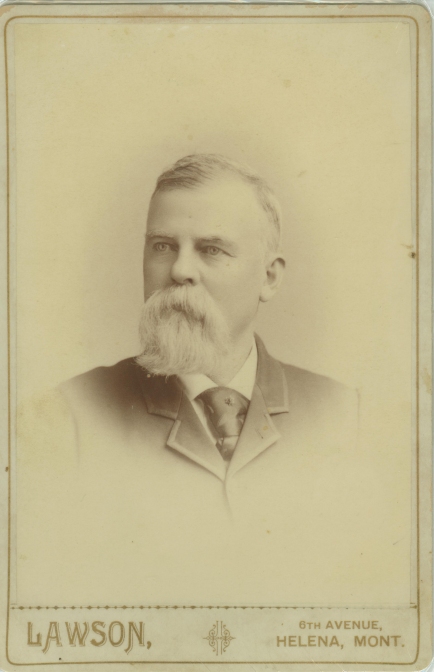
ABRAHAM STEARNS BLAKE
MONTANA PIONEER
Abraham Stearns Blake was born in New Haven, Addison
County, Vermont, November 29, 1837 of Puritan ancestors.
He was the sixth in a family of seven children.
His mother Marie died when he was four, and the younger children were
raised by a step-mother. His father Abijah
was a sea-captain who would be gone from home “sometimes for a year at a
time.”
In 1855, at age seventeen, Stearns left his home in the East and sailed, via Nicaragua, to California. He found the city of San Francisco “fascinating to a farm boy from the hills of Vermont.” He was soon anxious, however, to leave the fascinations of the city for the excitement of the gold fields. He joined a group of young men who were headed for Yuba City and he stayed in that area for the next six years.
In 1861 Stearns journeyed to Portland, Oregon to join his brother Levi Lowell Blake. Levi, who was more than seven years older than Stearns, had been living near Fort Owen in the Bitter Root Valley of Montana (Washington Territory), and together they returned to that area, prospecting in Idaho along the way.
Upon his arrival in the valley, Stearns met Perry W. McAdow and Major William Graham. With gold foremost on their minds they soon left the Fort for the gold fields at American Fork in the Deer Lodge Valley. They were among the first prospectors at Gold Creek and Stearns is credited with being “the first man in Montana to find gold in paying quantities.” He counted this summer at the American Fork as “one of the happiest of my life
While at Gold Creek Stearns became associated with Granville and James Stuart, and soon these men, including S. T. Hauser (Territorial Governor, 1885-87) moved from Gold Creek to Bannack City. This was late in the year 1862 when Bannack City consisted of a store and three log cabins.
Together these men planned the “1863 Stuart Expedition to the Yellowstone Country.” James Stuart was elected Captain of the venture, and the purpose was to “prospect for gold and secure townsites in the Yellowstone Basin.
Fifteen men were on the ill-fated Yellowstone Expedition; seven were wounded
in a battle with the Crow Indians (two of the wounded died by their own hand to keep from holding up the rest of the party) and the survivors felt more than lucky to be alive when they finally returned to civilization, such as it was. They had traveled “sixteen hundred miles through the Crow Nation, and for the last twelve hundred, without tents or even a change of clothes.”
After this harrowing adventure Stearns returned to Bannack for a short time, but soon he joined Levi, who “had some valuable claims” near Idaho City. They stayed in that area for four years.
Both of the brothers returned to the Bitterroot Valley and Fort Owen many
times, but in 1867 “tired of a miners life,” Stearns returned to Fort Owen
to live. For the next two years he farmed the
land around the fort with his friend and companion, Major John Owen. John
Owen recorded in his diary “I have a Jewel in young Blake.” “He is a Jewel, always doing Something.”
At Fort Owen Stearns met and married Mary Use. Mary was an Indian orphan from the Shoshone Indian tribe, who had come to live with John Owen and his Shoshone wife, Nancy. Mary Use helped to care for Nancy who was ill, and was her friend and helpmate until Nancy’s death in 1868.
With the Homestead Act of 1869 Stearns and Mary acquired 320 acres at Victor, Montana, where they farmed 100 acres and raised hogs and cattle. There they built one of the most elegant homes in the Bitterroot Valley.
During the battle of the Big Hole in 1877, Stearns fought as a civilian against the Nez Perce. This battle lasted only a few weeks as the Indians continued on their trek toward their destination, the Canadian Border. There the Nez Perce surrendered to federal troops. This act, with the familiar statement of Chief Joseph, -- “I will fight no more, forever” – virtually ended Indian resistance in Montana.
Stearns was one of the discoverers of the Curlew Mine at the mouth of Big Creek, not far from his home. Some three million dollars of Galena (lead & silver) ore was taken from the Curlew during the 1880’s and 1890’s, making it one of the most significant and prosperous mines in the valley.
ABRAHAM STEARNS BLAKE was truly one of the earliest pioneers of Montana, coming at a time when scarcely a thousand white men lived in the entire territory. He was made a Master Mason in 1858 and was a Republican from the formation of the party. He played an important part in the history of Montana; being elected a Member of the House of Representatives at its first session, 1889-90, and a Delegate of the State Legislative Assembly in its second session, 1891-92.
Mary Use Blake and Abraham Stearns Blake lived out their lives in their beautiful
home at Victor. They had eleven children. One of the first six, Joseph, lived to age seventeen,
while five others; Richard, George, Emma, Frank and Nellie, died in their
childhood. Five more children followed; Julia
Blake Yates, John A. Blake, Anna Blake Reed, Edward Blake and Bertha Blake
Rowan. All were well-loved, life-long residents
of the community of Victor, Montana.
By: Pat Close